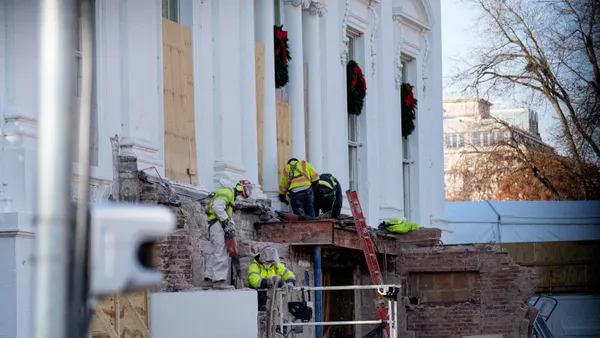Dive Brief:
- The New York City Department of Buildings has introduced new contractor and developer protocols on the heels of New York Gov. Andrew Cuomo's recent order that most construction in the city be halted in order to stem the spread of the coronavirus. Until further notice, the only types of work allowed to continue in the city are emergency construction, work on essential facilities and projects that require only one on-site worker.
- Emergency construction work includes projects that will help protect the health and safety of a building's occupants, as well as restoration of heat, hot water or power. The DOB is also allowing work to continue on projects that would be unsafe if construction stopped. Essential facilities include roads, bridges and transit infrastructure; utilities; healthcare facilities; transitional housing and homeless shelters; and affordable housing.
- The department has also revoked all After Hours Variance (AHV) permits, which authorize night and weekend work, and will only issue them for essential or emergency construction projects going forward. Contractors violating the DOB's new rules face fines of up to $10,000.
Dive Insight:
In a media statement, DOB Commissioner Melanie E. La Rocca said the department is "ready to enforce this critical ban on nonessential construction to help protect New Yorkers during this pandemic.
"Anyone breaking these rules should expect stiff enforcement — we simply cannot afford to continue business as usual.”
Last Monday, according to Andrew Rudansky, DOB press secretary, the department began enforcement inspections of the city's 35,000-plus active construction sites. As of April 2, the department had issued more than 100 violations and stop-work orders for noncompliance with Gov. Cuomo's order. However, he said, overall, the DOB has seen "overwhelming compliance."
More than 99% of nonessential construction sites have either shut down or are in the process of doing so. The DOB's online map shows the city’s ongoing essential projects.
Where construction work is allowed to continue, contractors must practice social distancing in all areas, including elevators, meal areas and along paths of egress.
Projects that have stopped construction must also adhere to DOB guidelines for a safe and secure project shutdown. The owner has the ultimate responsibility for making sure the site does not pose a danger to the public and that it is properly maintained and secured throughout the suspension period.
Owners must:
- Conduct weekly safety inspections, or designate a representative to do so, and maintain logs of the inspections on the project site.
- Maintain sidewalks next to the project in a safe condition.
- Remove garbage, debris and standing water.
- Safely store remaining materials and equipment, including cranes.
In Los Angeles last week, reportedly prompted by citizen complaints about active jobsites they perceive to be unsafe, the city's Department of Building and Safety (LADBS) announced that owners and contractors will be required to develop COVID-19 exposure control plans and keep them on site where they can be viewed by department inspectors. LADBS said projects could be subject to a forced shutdown or the withholding of inspections until the owner and contractor develop and enforce the required plan.
Some LADBS guidance for the exposure control plan include:
- Social distancing of at least 6 feet.
- Ensuring workers have the necessary personal protective equipment.
- Designation of a site-specific COVID-19 supervisor to enforce LADBS guidelines.
- Minimizing worker interaction during equipment and material pickup or delivery.
- Staggering trades to reduce the density of workers on the project.
- Discouraging workers from sharing phones, tools, desks and offices.













